A West African Journey
I had forgotten about the film festival. The airport at Abidjan was full of people all heading for Ouagadougou for the thirteenth Fespaco.
Abidjan? Fespaco? Ouagadougou? West African travels are superb if you avoid civil wars, coups and terrorist attacks: the January 2016 attacks in Ouagadougou reminded me of my travels there in much quieter times.
……
My flight to Ouaga in Burkina Faso was very different from the unpleasant experiences leaving Nigeria a few weeks earlier: the courtesy bus from my hotel to the Abidjan, Côte d’Ivoire, airport was painless, the check-in was painless, seat allocation was painless, and the clearance of customs and immigration was painless. On the other hand, the sweltering departure lounge was very painful, with a glaring sun burning up everything inside, no ventilation, plastic seats and hordes of people swatting flies and mopping sweaty brows. I kept trying to seize a seat near the door leading to the tarmac where occasional breaths of air came in, but one or two others had the same idea … and they were bigger and pushier.
After the cleanliness and orderliness of pre-2004-civil war Abidjan, it was somehow refreshing to arrive in Ouaga with its dusty, unlit streets, its smoking mopeds, and its un-metered taxis. There were old revolutionary slogans still visible on the walls of the airport, and arriving passengers and their hand luggage were searched in screened booths. Ahead of me in the line were two generously built American women, who objected to the treatment, and kept trying to jump the queue. I would have loved to peek around the curtains as they were searched:
- And what do you have in here, Madam?
- How dare you! That is my …
I took a taxi to the Hotel de la Paix where I was lucky to get a room, as the place was fully booked for the film festival from the following day onwards. A room without a view was found for me: a tin door opened onto a bare concrete room with a shower recess and a lavatory. There was a simple bed and a built-in cupboard with a hole in its roof giving access to bandits, pillagers and mosquitoes.
FESPACO (fespaco.bf) was and still is big business. The Festival Panafricain du Cinéma et da la Télévision de Ouagadougou had twenty or so African countries, plus the UK, USA, Cuba, Brazil, France, Belgium and other countries enter films for its thirteenth festival (the 25th festival will be held in 2017), and almost 3000 delegates swamped Ouaga when I was there. Numerous stalls were set up near Place UN – bars, little restaurants or snack bars, souvenir shops, tables offering local curios, and a whole stall of condoms with blue-painted wooden bananas used for demonstrations.
- But doctor – I can’t be pregnant! We always placed un préservatif on the banana before we had sex!
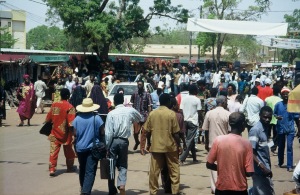 The whole area had a delightfully festive air. During the day, and in the early evening, the area was packed with festival delegates, tourists, vendors, beggars, sight-seeing Ouagalis and police, but later in the evening all the goodies were simply left in the stalls, some of them covered by a sheet of hessian or fabric, some left open to the night sky, leaving the priceless carvings and condoms in the open air guarded by a few wandering armed policemen.
The whole area had a delightfully festive air. During the day, and in the early evening, the area was packed with festival delegates, tourists, vendors, beggars, sight-seeing Ouagalis and police, but later in the evening all the goodies were simply left in the stalls, some of them covered by a sheet of hessian or fabric, some left open to the night sky, leaving the priceless carvings and condoms in the open air guarded by a few wandering armed policemen.
The following morning, Hotel de la Paix staff helped me by telephoning Le Pavillon Vert (hotel-pavillonvert.com) where I was able to book a nice little room for a few nights.
A young man from the Hotel de la Paix loaded me and my bags onto the back of his moped and took me to the Pav Vert (PV). I offered him “un petit cadeau” or a beer … and we settled on CFA 300 “for petrol” so I gave him CFA 500 and he promised to come back some day to give me a guided tour of the city … He never did.
The PV (where my room with a fan cost CFA 3000 – then about US$11.00 per night) is a charming collection of buildings scattered around a central courtyard, with thatched gazebos for eating, writing or relaxing, and an open-air bar and snack bar. If you wanted to do your own laundry, out the back there was a tub shared with the local chickens. A feisty French woman with a shock of red hair ran the place when I was there. My room had four concrete walls, a concrete floor, iron shutters on the window and the door, a few hooks in the wall, and a low-slung bed underneath a slowly grinding ceiling fan on the concrete ceiling. The shared showers and lavatories were a few doors away, and there were open-air basins for shaving or washing teeth.
One day I was sitting in the lovely PV garden writing postcards and diaries and notes when a lad arrived carrying shirts made with patch-work patterns of all sorts of local fabrics, including the Fespaco logo – a bolt of the official fabric must have fallen off the back of a donkey. I was soon the proud owner of a multi-coloured patchwork quilt of a shirt. I did not know if it would fit me, nor if it would survive its first washing, but several weeks later, while I was walking down a side street in Bordeaux, wearing this shirt, a car of young people drove past, and one of the occupants called out Fespaco! Yes, the shirt really was quite distinctive … and I still have it, many years and many washes later.
Dusty and disquieting streets?
Quite a few of Ouaga’s roads were under repair, being dug up, or having new drains installed, and a fine red dust was everywhere. Some people wore industrial facemasks to stop dust inhalation, and one little girl I spotted was even wearing swimming goggles.
At night it was rather disconcerting to be alone – I don’t know where the 3000 film delegates went – walking past the Black Soul Distraction Restaurant and Dancing in a dark street. The only light came from small smoky fires lit on top of truck tyres to repair their punctured tubes. It was disturbing to be a single skinny white guy in that dark dusty street and to see, heading towards me, an ominous group of large African men silhouetted in the yellow beams of an oncoming car.
It was like something out of a rather poor horror film – without the Norman Bates zig-zag sawing violin music – but lots of friendly and welcoming exchanges of “Bon soir – Ca va?” … ”Ca Va bien” later, and I wondered why I had any qualms at all. This was not Nigeria.
And off to church
One Sunday I went to church in the suburb of Zapayo. I got there at 8.30 am and the service started at 9.00 am. As the place gradually filled up, I eventually realised that my usual habit of sitting on the right was not right there – all the men and boys were on the left-hand side of the church, and the other side was occupied solely by women and girls – and me.
Eventually I moved, rather than try to strike a blow for the International Men’s Liberation Movement. Although I had on my best T-shirt and jeans, I was considerably under-dressed, as everyone else was in his or her Sunday best, including quite a few shirts or robes with religious themes such as crucifixes or “Ave Maria” woven into the fabric. The half hour before the service began was used for “choir practice” as we were taught the words and tunes of some new hymns and of various responses. Eventually two massive loud speakers were set up on either side of the church, and an electric organ began belting out reggae versions of the hymns and responses we had just been taught.
The old man in front of me, to whom I was talking after the service, couldn’t quite believe that I was really all the way from Australia. I don’t think I could, either. It seemed a long long way from pavlovas, lamingtons and Tasmanian smoked salmon.
The day after my church visit I decided to go to Bobo-Dialassou, packed an overnight bag and took a taxi to the Gare Sans Frontièrs, whose last bus had just gone. My driver then took me to Gare SOGEBAF (Societé Genérale Bamago et Frères – a great name for a bus company!) on Avenue Kadiogo in Petit Paris. SOGEBAF had a bus going soon, so I bought a ticket, declined the offer to buy CFA 25,000 insurance in case of accidents (what was I letting myself in for?) and we left on time.
The bus was quite c omfortable when we started.
omfortable when we started.
There were only half a dozen of us on board and although there were plenty of seats, a man took the seat next to me. I think he wanted to sit there to be near his wife, daughter and mother-in-law in the seats in front of me, although when I asked him if they were his wife, daughter and mother-in-law, he denied it … or did not understand my French. Our conversation for the five-hour journey consisted of highly intellectual exchanges:
- Bridge
- Yes
- Village
- Ah!
It was hard, at times, to remember that Ouaga was a country’s capital city, as there was terrible poverty evident just minutes and metres outside the “city”. Burkina Faso is one of the poorest countries in the world. The United Nations Human Development Index ranks the country 183 of 187. [By comparison, Australia is No 2 with Norway in the top slot, and Thailand is No 93.] Almost half the population lives on less than $1.25 per day. The level of education is low with a literacy rate of less than 30%. The country is weakened by the wide-spread of HIV and AIDS.
Them old cotton fields back home
Burkina Faso has virtually no natural resources or natural assets, and though quite a few villages seemed to have vast mounds of cotton (a crop that accounts for about 40% of Burkina Faso’s GDP) (cottonmadeinafrica.org), for the most part the villages w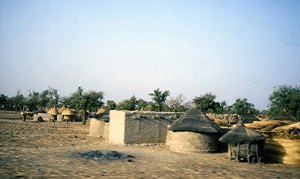 ere little more than collections of round or square mud-brick huts with thatched roofs, gathered in circles with walls linking one building to another, to make mini walled townships. Outside the “city walls” were grain silos, with rounded woven bottoms supported above the ground by a system of interlaced branches of trees, and roofed with conical hats of thatch. An occasional pig, flocks of goats, and some cattle and guinea fowls completed the picture.
ere little more than collections of round or square mud-brick huts with thatched roofs, gathered in circles with walls linking one building to another, to make mini walled townships. Outside the “city walls” were grain silos, with rounded woven bottoms supported above the ground by a system of interlaced branches of trees, and roofed with conical hats of thatch. An occasional pig, flocks of goats, and some cattle and guinea fowls completed the picture.
Most villages seemed to have their own well, although occasionally it was more than a kilometre from the cluster of houses. Women and children were the water haulers, whether the well was just a hole in the ground with buckets and lengths of rope draped over the baked-clay surrounds with deep rope-engraved grooves showing years of use, or concrete structures with mechanical pumps. Most of the wells seemed to be very deep. I watched a small boy pulling up a bucket. After eight or ten pulls, each of more than a metre of rope, there was still no sign of the bucket … then the bus moved on … so the poor kid might still be hauling up miles of rope to get one bucket of water.
The French had a hand in Burkinabe politics for many years – from 1896 to the days when the country was known as Upper Volta. After its independence from France in 1960 the country went through a name change (1984), a series of coups (1966, 1980, 1983, 1987), a military mutiny (2011) and another coup last year. French is the official language of the country – although many local languages are also spoken.
Wherever the bus stopped, and in particular at the village of Pâ (population 8649), hordes of kids and adults besieged us, trying to sell onions, bread – French-style baguettes as well as the bright yellow local variety – garlic, green peppers, peanuts, packets of small cakes, and the inevitable plastic bags of water or ginger beer. Brochette sellers offered skewers of char-grilled chicken, mutton, beef or offal, as well as whole roast chickens. I was the only white person on the bus and in the village and the kids called out to me:
- Hey! Blanc! Where you go?
I got a few smiles by calling back:
- Allô! Et vous? Ou allez vous, noirs?
Kids (and people in general) carried huge loads on their heads: water jars, building materials, trays of fruit, household goods. I watched one child balance a tray of oranges as he bent down to pick up a box that had fallen off the top of a pile of empty cartons he was dragging, for some reason, along the empty road.
When we got to Bobo, I asked for directions to the RAN Hotel but was told to take a taxi, as it was too complicated to explain the route. I set off on foot into the dust and dark, hoping that I was more or less heading in the right direction and that no more hulking silhouettes would loom up at me through the dusky gloom.
A little girl, selling oranges and a few tired black bananas, sat next to me as I took a breath of air one afternoon. She was five or six years of age, dressed like so many kids in tattered clothes tied together with bits of old string, and with dusty bare feet arms and legs, and dusty close-cropped hair. I watched her as she sucked one of her oranges dry, and I wondered if she had parents who knew or cared where she was or what she was doing, if she had a home to go to …
One of UNESCO’s aims was “to give every child an identity”. Many kids are not registered at birth, and officially do not exist at any stage in their life – such simple things we take for granted. Even the man next to me on the bus to Bobo had his birthdate shown on his identity card – Vers 1946 (About 1946).
Bobo was a marvellous friendly small city of about half a million people. Many of its public buildings were quite stunning. The Sudanese-style Grand Mosquée is said to be the largest structure of this kind in the country.
The similarly styled 1930s Railway Station makes boarding a train a pleasure, and at the exciting Grand Marché there was a colourful caravanserai of tailors, fruit and vegetable vendors, household goods stalls, fresh and not-so-fresh fish and meat stalls, and even more bolts of the colourful cotton fabrics worn by the women – and made into souvenir shirts for Fespaco delegates and Australian visitors.
Despite the splendid railway architecture, the train journey back to Ouaga was not as exciting as the bus to Bobo, as the return journey was through the night with little to be seen outside, and French-dubbed films to be seen inside: Police Academy 5 and Cocaine Wars.
It was perhaps appropriate that my next destination was Paris – about 4000 kilometres by air from Ouagadougou but millions of kilometres away in economic and emotional terms … but still not far enough not to be connected by the appalling November 2015 ISIL attacks in Paris and by the January 2016 Al Qaeda attacks in Ouagadougou.
……………
- Journey: March 1993
- Text and photographs (excluding Le Pavillon Vert): © Christopher Hall 2016
- If you enjoyed this story please scroll down to see earlier stories and forward the blog address to your friends www.hallomega.com
- If you would like to receive automatic notification of future postings on this blog please click the FOLLOW button on your screen
……………
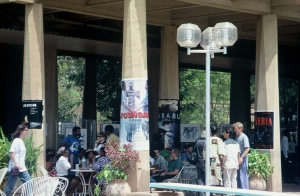
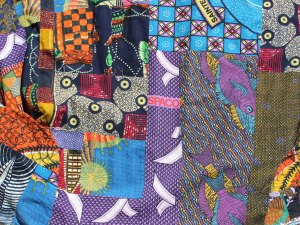
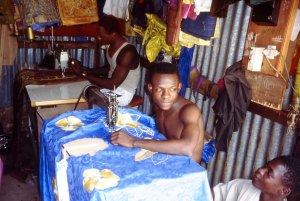
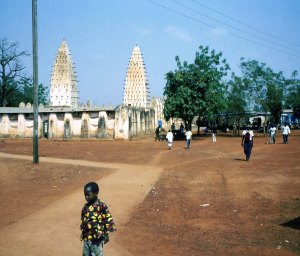

You really do know how to spin a yarn.
Thank you
G
LikeLike
Thanks Gill – lots of yarn spun in West Africa it seems!
Chris
LikeLike
Really nice post. Please follow us 🙂
LikeLike
Dear Tote, You have made my day by giving me this to read and enjoy as I head towardsCentral. The first train was a mere 30 minutes late – signal problems! Felt like I was in KL sitting in the sweltering heat and humidity for an hour at Landsborough . At least now this train is freezing. It’s too hard typing on the iPhone in this rock and rolling train. Keep your wonderfully interesting and entertaining travelogues coming. You really are very brave and so adventurous! Love Trish
LikeLike
Hey bro from Bobo. Love the shirt
LikeLike